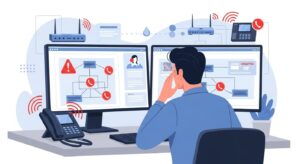
SIP Trunking vs Traditional Phone Systems: A Cost Comparison
SIP trunking delivers substantial cost savings compared to traditional phone systems through reduced infrastructure requirements and competitive pricing models.
- Elimination of expensive PRI line fees and physical infrastructure reduces upfront and ongoing operational costs.
- Flexible pay-per-channel pricing aligns expenses with actual usage rather than fixed capacity requirements.
- Significant savings on long-distance calling through internet-based routing, which eliminates traditional carrier fees.
- Businesses can achieve cost reductions up to 75% when switching to SIP trunking solutions.
The financial advantages are so compelling that organizations still using traditional phone systems risk unnecessarily high communication expenses.
Business communication costs continue rising as traditional phone systems burden organizations with expensive infrastructure, rigid pricing models, and costly maintenance. Poor communication alone costs businesses an estimated $12,506 per employee annually in lost productivity and operational inefficiencies.
When comparing SIP trunking vs traditional phone systems from a cost perspective, the differences extend beyond monthly service fees. Infrastructure investments, maintenance expenses, scalability costs, and long-term operational efficiency all contribute to the total cost equation that determines the impact of your communication budget.
How Do SIP Trunking vs Traditional Phone Systems Differ in Cost Structure?
Traditional phone systems operate on decades-old infrastructure that requires capital investment and ongoing maintenance. These systems rely on physical copper lines, on-premises PBX hardware, and complex installations that lock businesses into expensive, inflexible arrangements.
SIP trunking transforms this cost structure by leveraging your existing internet connection to deliver voice communications. Instead of paying for physical phone lines and maintaining costly hardware, you pay for virtual channels that can be added or removed instantly based on your actual needs.
The fundamental cost difference lies in how each system handles capacity and growth. Traditional systems require expensive line installations for every additional connection, while SIP trunking scales digitally without infrastructure changes. This flexibility creates immediate cost advantages and positions your business for more predictable long-term expenses.
What Are the Infrastructure Investment Differences?
The infrastructure requirements between traditional and SIP systems create different cost scenarios that impact both initial investments and ongoing operational expenses.

Traditional Phone System Infrastructure Costs
Traditional phone systems demand substantial upfront investments that can strain business budgets. When evaluating SIP trunk vs PBX hardware costs, traditional PBX installations typically require significant per-user costs, depending on system complexity and feature requirements. These systems require dedicated phone lines, specialized wiring, and professional installation services that add setup expenses.
Businesses must purchase and maintain physical equipment, including PBX servers, phone handsets, switching equipment, and backup systems. Each component requires regular maintenance, replacement parts, and eventual upgrades as technology evolves. Hardware replacement cycles create predictable but substantial capital expenses that occur regularly throughout the system’s lifespan.
The infrastructure complexity includes physical space requirements, power consumption, and specialized technical expertise for system management. These hidden infrastructure costs often exceed initial budget projections and create ongoing operational burdens.
SIP Trunking Infrastructure Requirements
SIP trunking eliminates most traditional infrastructure requirements by operating through your internet connection. Instead of dedicated phone lines and complex hardware installations, you need only IP-compatible phones or software applications on computers and mobile devices.
The infrastructure investment primarily involves ensuring adequate internet bandwidth to support your expected call volume. Each concurrent call requires approximately 85 kilobits per second of bandwidth, meaning most modern business internet connections can support multiple simultaneous calls without upgrades.
When comparing VoIP vs analog infrastructure, cloud-based SIP systems eliminate the need for on-premises servers, reducing power consumption, maintenance requirements, and physical space needs. This streamlined approach translates directly into lower setup costs and reduced ongoing operational expenses.
Setup and Installation Cost Differences
Traditional phone system installations involve complex processes requiring specialized technicians, physical line installations, and extensive configuration procedures. Setup fees vary, with additional charges for each phone line, extension, and advanced feature configuration.
SIP trunk installations are typically completed within hours rather than days or weeks. Most providers offer automated provisioning that activates service immediately upon account verification. Setup fees, when charged, remain much lower than traditional installations and often include comprehensive feature packages at no additional cost.
The simplified installation process reduces business disruption and eliminates the need for extended downtime during system deployment. This operational advantage provides indirect cost savings through maintained productivity during the transition period.
How Do Monthly Operating Costs Compare?
Monthly recurring expenses are the most apparent cost difference when comparing SIP trunking vs traditional phone systems, with pricing structures that differ in flexibility and predictability.
| Cost Category | Traditional Phone Systems | SIP Trunking |
| Setup & Installation | High upfront costs, professional installation required | Low to no setup fees, automated provisioning |
| Monthly Line Fees | Per-line charges regardless of usage | Pay-per-channel based on concurrent calls needed |
| Hardware Requirements | Expensive PBX equipment, regular replacements | Minimal hardware, cloud-based infrastructure |
| Maintenance | On-site technician visits, emergency call charges | Remote support, automatic updates |
| Long-Distance Calls | Per-minute charges, premium rates | Often included in monthly fee or drastically reduced rates |
| Scalability | Additional PRI circuits, hardware expansion | Instant channel adjustments, no hardware changes |
| Typical Monthly Cost | Fixed high costs with usage surcharges | Flexible pricing starting at competitive per-channel rates |
Traditional Line Rental and Service Fees
Traditional phone systems generate predictable but expensive monthly recurring charges through line rental fees, service charges, and usage-based billing structures. Each physical phone line requires individual monthly fees, regardless of actual usage levels. Businesses often pay for more capacity than needed to avoid busy signals during peak periods.
PRI lines, which support multiple simultaneous calls, typically cost several hundred dollars monthly and provide 23 voice channels per circuit. Organizations requiring more capacity must purchase additional PRI circuits, creating expensive jumps in monthly costs even for modest capacity increases.
Long-distance charges add substantial variability to monthly expenses. Traditional carriers often charge premium rates for calls outside local areas, creating unpredictable monthly bills that complicate budget planning and cost control efforts.
SIP Channel Pricing Models
SIP trunking offers flexible pricing structures that align costs more closely with actual business needs. Pay-per-channel models allow organizations to purchase exactly the capacity required, avoiding the waste associated with unused traditional phone lines.
Unlimited calling plans provide predictable monthly expenses while eliminating per-minute charges for domestic long-distance calls. This pricing transparency enables better budget planning and removes the uncertainty associated with variable usage charges that characterize traditional systems.
Most SIP providers offer scalable pricing tiers that provide volume discounts as channel counts increase. This structure supports business growth by reducing per-channel costs as organizations expand their communication needs over time.
Long-Distance Calling Costs
The VoIP vs analog calling cost analysis reveals that SIP trunking delivers dramatic savings on long-distance calling through internet-based routing. Calls between SIP-enabled locations often cost nothing beyond the basic service fees, eliminating traditional carrier charges entirely.
The elimination of separate long-distance carriers and their associated fees simplifies billing while providing cost reductions. This benefit becomes particularly valuable for businesses experiencing growth in different markets or expanding remote work capabilities.
What Are the Maintenance and Support Cost Implications?
Ongoing maintenance is a significant cost category where traditional and SIP systems differ in both direct expenses and operational impact.
Traditional System Maintenance Requirements
Traditional phone systems require ongoing maintenance that creates both direct costs and operational disruptions. Hardware components need regular servicing, software updates, and eventual replacement as technology advances. On-site service calls from specialized technicians generate substantial hourly charges plus travel expenses.
System failures often require immediate professional intervention to restore communication capabilities. Emergency service calls typically incur premium charges, especially during after-hours periods when business operations depend on reliable phone service. Component replacements, system upgrades, and capacity expansions all require professional installation services.
The specialized knowledge required for traditional system maintenance limits organizations’ ability to handle routine tasks internally. This dependency on external technical support creates ongoing operational expenses and potential delays in resolving communication issues.
SIP Trunking Support Models
SIP trunking providers typically handle system maintenance and updates remotely, eliminating most on-site service requirements. Software updates deploy automatically without business disruption, and system monitoring identifies potential issues before they affect service quality.
Technical support operates through cloud-based systems that enable rapid problem diagnosis and resolution. Many issues can be addressed through online interfaces or phone support without requiring on-site visits. This remote support model reduces both direct costs and business disruption associated with maintenance activities.
The SIP trunk vs PBX maintenance comparison clearly favors SIP, as provider-managed infrastructure means businesses avoid the costs and complexity of maintaining communication equipment. System reliability improvements, security updates, and capacity optimizations occur transparently without requiring internal IT resources or external service contracts.
Upgrade and Expansion Costs
Traditional phone system upgrades often require new hardware, additional line installations, and system reconfiguration. Adding capacity typically involves purchasing additional PRI circuits or expanding PBX hardware capabilities, creating expensive barriers to growth.
SIP trunking enables upgrades and expansions through simple online configuration changes. Adding channels, phone numbers, or advanced features costs far less than traditional system expansions and can be implemented immediately without hardware installations or service disruptions.
Feature upgrades in SIP systems often involve software updates rather than hardware replacements. This approach provides access to advanced communication capabilities without the expenses associated with traditional system enhancements.
Which Pricing Models Offer the Best Value?
Understanding different pricing structures helps businesses select the most cost-effective approach for their communication needs and growth patterns. Each model offers distinct advantages depending on call volume patterns, growth expectations, and budget preferences:
| Pricing Model | Best For | Cost Structure | Key Benefits | Considerations |
| Metered Plans | Low to moderate call volumes | Pay per minute | Pay only for usage, predictable rates | Costs can vary monthly with usage |
| Unlimited Channel | High call volumes | Fixed monthly fee per channel | Predictable billing, no usage limits | Higher base cost if usage is low |
| Hybrid Models | Mixed calling patterns | Fixed domestic + metered international | Flexibility for different call types | More complex billing structure |
| Volume Discounts | Large enterprises | Reduced per-channel rates at scale | Lower costs as you grow | Minimum volume requirements |
| Pay-as-you-go | Seasonal or variable usage | Usage-based with no contracts | Maximum flexibility | Requires careful usage monitoring |
How Does Total Cost of Ownership Compare Over Time?
Long-term financial analysis reveals the true cost differences between traditional and SIP systems, with implications that extend well beyond initial implementation expenses.
Short-term vs Long-term Cost Considerations
Initial cost comparisons often favor SIP trunking through lower setup fees and reduced infrastructure requirements. However, the long-term financial advantages become even more pronounced as organizations benefit from reduced maintenance costs, scalability without capital investment, and operational efficiency improvements.
Traditional systems may appear less expensive initially if existing infrastructure remains functional. However, aging equipment replacement, capacity expansion costs, and increasing maintenance requirements typically result in higher total ownership costs over three- to five-year periods.
SIP trunking costs remain more predictable over time due to provider-managed infrastructure and transparent pricing models. Organizations can budget more accurately for communication expenses without concerns about unexpected hardware failures or capacity upgrade requirements.
ROI Timeline and Break-even Analysis
With a SIP trunk vs PBX analysis, most organizations achieve a positive return on investment within the first year through reduced monthly costs and eliminated maintenance expenses. Break-even periods typically range from six to eighteen months, depending on current system costs and SIP pricing models.
Businesses with high long-distance calling volumes often achieve faster ROI through immediate savings on per-minute charges. Organizations requiring frequent capacity changes benefit from SIP flexibility that eliminates the costs associated with traditional line installations and disconnections.

The ROI calculation should include indirect benefits such as increased productivity through advanced features, reduced downtime during system maintenance, and improved business continuity through cloud-based infrastructure resilience.
Scalability Cost Impact
Traditional phone systems create expensive barriers to growth through hardware upgrades and additional line installations. Each capacity expansion involves capital investment, installation disruption, and ongoing maintenance costs that can discourage business growth or limit operational flexibility.
SIP trunking enables cost-effective scaling that grows with business needs without infrastructure changes. Adding capacity involves simple configuration updates that can be implemented immediately, allowing organizations to respond quickly to changing communication requirements. SIP systems adapt to changing needs without the financial barriers that traditional systems impose on business development.
How Can You Build a Financial Case for SIP Trunking?
Creating a compelling business justification for SIP implementation requires analyzing direct costs and operational benefits that impact long-term business success.
Cost Savings Calculator Considerations
An accurate phone system cost comparison requires evaluation of all expense categories, including infrastructure, monthly service fees, maintenance costs, and scalability expenses. Traditional system costs often include hidden elements such as emergency service calls, hardware replacement cycles, and capacity expansion limitations.
SIP trunking evaluations should consider internet bandwidth requirements and any necessary upgrades to support expected call volumes. However, most modern business internet connections provide adequate capacity for typical communication needs without additional monthly costs.
Long-term projections should account for business growth expectations and how each system handles capacity increases. SIP systems typically provide better cost predictability as organizations expand their communication needs over time.
Business Impact Beyond Direct Savings
SIP trunking delivers operational benefits that create indirect cost savings through improved productivity and business efficiency. The VoIP vs analog feature comparison highlights how advanced capabilities, such as call forwarding, video conferencing, and mobile integration, enable better collaboration and customer service capabilities.
Remote work support through SIP systems can reduce office space requirements and associated overhead costs. Employees can access full business communication capabilities from any location with internet connectivity, potentially reducing facility expenses while maintaining professional presence.

Business continuity improvements through cloud-based infrastructure reduce the risk and costs associated with outages. Automatic failover capabilities and geographically distributed systems provide better service reliability than traditional on-premises installations.
Implementation and Migration Costs
Any thorough phone system cost comparison reveals that SIP implementation typically involves lower transition costs than traditional system replacements due to faster deployment and reduced installation complexity. Most organizations can complete migrations with minimal business disruption and without extensive employee retraining.
Number porting processes allow businesses to retain existing phone numbers during the transition, eliminating the costs and complications associated with changing published contact information. Most SIP providers handle porting procedures as part of the implementation.
Training remains minimal due to intuitive interfaces and familiar phone functionality. Advanced features can be implemented gradually, allowing organizations to realize immediate cost benefits while exploring enhanced capabilities over time.
Frequently Asked Questions
How much can businesses typically save with SIP trunking? Research shows that businesses can achieve cost savings of up to 75% compared to traditional phone systems, with some organizations experiencing even higher reductions depending on their current infrastructure and calling patterns.
What are the hidden costs of traditional phone systems? Traditional systems often include unexpected expenses such as emergency service calls, hardware replacement cycles, capacity expansion fees, long-distance charges, and ongoing maintenance contracts. These costs can exceed initial budget projections and create unpredictable monthly expenses that complicate budget planning.
How do I calculate ROI for switching to SIP trunking? Calculate ROI by comparing total current communication expenses (including infrastructure, monthly fees, maintenance, and expansion costs) against projected SIP costs over a three-year period. Include indirect benefits such as improved productivity, reduced downtime, and business continuity improvements in your analysis.
Ready to Transform Your Communication Costs?
The cost comparison between SIP trunking vs traditional phone systems reveals financial advantages for organizations ready to modernize their communication. From reduced setup costs and lower monthly expenses to improved scalability and operational efficiency, SIP trunking provides a clear path to communication cost optimization.
SIP.US provides transparent pricing, reliable service, and the expertise needed to help your business achieve maximum cost savings through SIP trunking implementation. Our proven platform eliminates the complexity traditionally associated with transitions while delivering the cost-effective, scalable solutions that modern businesses require. Get started today and discover how much your organization can save by making the switch to SIP trunking.



